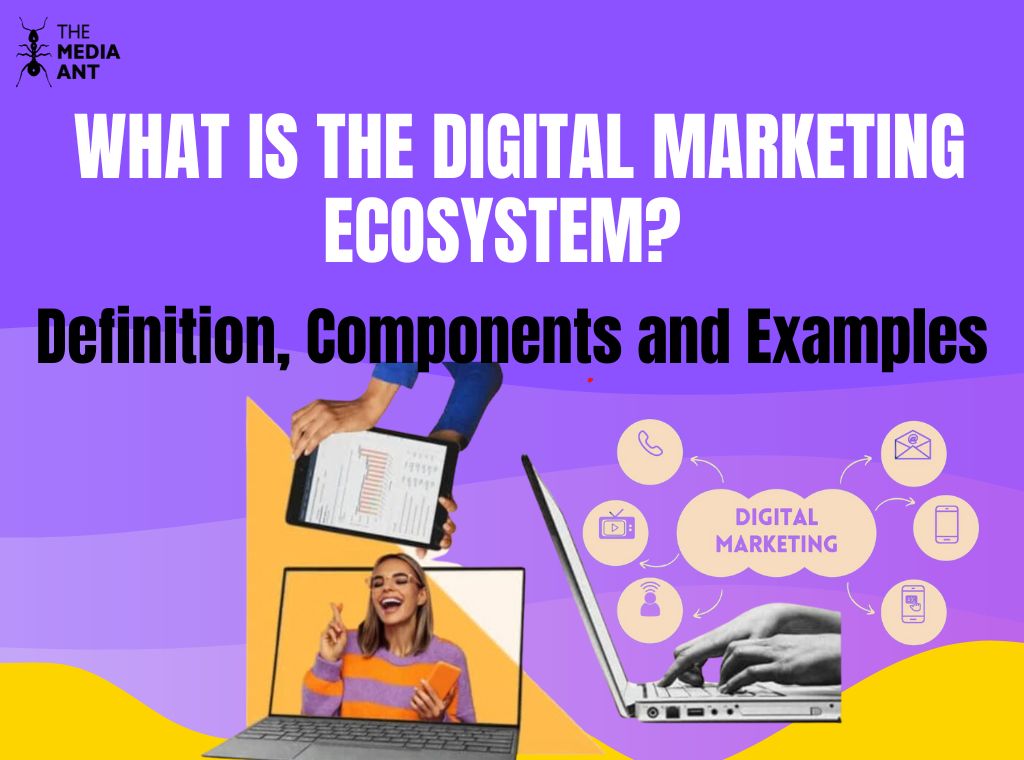Nowadays, the digital marketing ecosystem plays a crucial role in any marketing strategy. It encompasses a variety of strategies such as social media, email marketing, SEO, and online advertising, among others. These are key components that drive digital marketing efforts. The landscape of digital marketing is constantly evolving with updates in tools and techniques. The expansive reach of digital marketing leaves a significant impact on the minds of consumers and end customers.
What is the Digital Marketing Ecosystem?
The digital marketing ecosystem comprises all digital platforms linked to your brand. Like a natural ecosystem, it thrives on the synergy of multiple networks working together seamlessly. This includes your website, social media channels, video content, and other essential components of your digital marketing strategy.
Components of Digital Marketing Ecosystem
1. Website
Think of a website as the sleek storefront of a bustling city, drawing in passersby with its captivating displays and enticing offerings. It’s not just a virtual space; it’s the very essence of your brand, a digital ambassador that speaks volumes about who you are and what you stand for. Your website is where potential customers take their first steps into your world, exploring the products, services, and values you hold dear. In this bustling digital landscape, crafting a stellar website isn’t just important—it’s essential. It’s the cornerstone upon which your entire digital presence is built, setting the stage for meaningful interactions and lasting connections with your audience. So, as you embark on this journey through the digital ecosystem, remember that your website is more than just pixels on a screen—it’s your brand’s welcoming embrace in the vast online universe.
2. Brand
Your brand is the beacon that guides users and potential customers to your products or services. It serves as the public face of your company, communicating a distinct message about your offerings and values. This aspect is crucial because, without a strong brand, your website and marketing efforts struggle to stand out in the crowded marketplace. A well-defined brand not only sets you apart from competitors but also establishes a connection with your audience, fostering trust and loyalty. It’s the foundation upon which successful digital endeavors are built, ensuring that your business resonates with customers in a meaningful way.
3. Goals
Setting clear objectives and goals is paramount in the digital marketing ecosystem. Once these goals are established, crafting tailored strategies becomes more manageable. Digital campaigns entail various factors, including demographics, gender, and market analysis. It’s crucial to thoroughly examine these objectives before devising an approach, ensuring that the strategies align with the specific needs and objectives of the campaign.
4. Digital Platforms
Digital platforms play a pivotal role in the online marketing ecosystem by enhancing your brand’s visibility. While your website serves as the primary platform, you can also harness the power of email and social media channels such as Facebook or Twitter to expand your reach and engage with your audience effectively.
5. Search Engine Optimization(SEO)
SEO is one of the key elements in digital marketing tools. It is majorly used to get success in online marketing initiatives. SEO is a very important factor when it comes to online Ads. Search Engine Optimization (SEO) proves highly effective because, by establishing robust foundations rooted in authority and content quality, your website transforms into an automated system capable of qualifying users effortlessly.
6. Content Marketing
Compelling content is essential for setting your brand apart from competitors, and strategically marketing it on relevant platforms is crucial for attracting customers. A pivotal aspect of content marketing lies in maintaining a strong brand message and ensuring visual appeal, whether it’s through written content or videos. Alignment of the message across all mediums is paramount for maximum impact.
7. Social media marketing
In the realm of digital marketing, social media marketing holds significant sway in connecting with the precise audience and swaying them towards your brand. With consumers readily active on social media platforms, employing the appropriate approach becomes pivotal in effectively reaching out to them.
8. Email marketing
Email marketing involves reaching out to your audience directly via email, delivering engaging newsletters containing details about your products and services, which can lead to significant conversion rates.To ensure a successful and ethical email marketing strategy, it’s essential to approach it with subtlety, respecting the privacy of your clients and avoiding any sense of intrusion.
Benefits of Building a Digital Ecosystem
A digital marketing ecosystem is instrumental in keeping a brand relevant to its consumers, ultimately driving awareness and boosting sales. However, building an effective digital ecosystem requires careful planning and execution.
It’s important to recognize that not all digital ecosystems are well-organized from the start. Many organizations gradually develop their digital landscape, incorporating new applications as needed. Yet, to fully reap the benefits, it’s crucial to adopt a systematic approach.
This involves:
Identifying and mapping out every component of the digital ecosystem, ensuring a clear understanding of data flow across all systems.
Assessing the effectiveness of each asset and prioritizing systems based on their value and importance.
Implementing third-party risk management strategies to mitigate potential risks associated with external vendors and platforms.
Examples of Digital Marketing Ecosystem
- Digital Ad
2. Email Marketing

3. Content Marketing

4. Social Media Marketing
Conclusion
The digital marketing ecosystem offers a comprehensive framework for implementing marketing strategies, which significantly impact the sales dynamics of a brand. Success within this ecosystem hinges on the careful alignment and execution of various factors. Digital marketing serves as the linchpin for enhancing a brand’s visibility and connecting with the intended audience. It’s the driving force behind elevating a brand’s presence and resonance among its target consumers.
FAQs on Digital Marketing Ecosystem
1. What 3 components are involved in the digital ecosystem?
- Content: The information and media assets used to engage and attract audiences.
- Platforms: The digital channels and technologies utilized to distribute content and interact with audiences.
- Data: The insights and analytics gathered from audience interactions to inform marketing strategies and decisions.
2. How do you create a digital marketing ecosystem?
- Identifying Goals: Define clear objectives for your digital marketing efforts.
- Developing Strategy: Craft a plan tailored to your goals, audience, and available resources.
- Implementing Tactics: Execute various digital marketing tactics such as content creation, social media management, SEO, and email marketing.
- Monitoring and Optimization: Continuously track performance metrics and adjust strategies to improve results.
3. What is an ecosystem example?
An example of an ecosystem is a forest, where various species of plants, animals, and microorganisms interact with each other and their environment to form a complex, interconnected system.
4. What are the different types of digital ecosystems?
- Social media platforms
- E-commerce marketplaces
- Content publishing networks
- Software as a Service (SaaS) platforms
- Search engines and advertising networks
5. What is digital ecosystem management?
Digital ecosystem management involves overseeing and optimizing the interconnected network of digital platforms, technologies, and interactions to achieve business objectives efficiently and effectively.
The Media Ant functions as a cutting-edge advertising platform, dedicated to curating and acquiring prime media real estate. Employing its specialized knowledge, it empowers businesses to seamlessly connect with their desired demographics by strategically distributing ads across an array of digital channels, optimizing engagement and visibility.




![How Much Does Google Ads Cost [2025 Update] 8 How Much Does Google Ads Cost](https://www.themediaant.com/blog/wp-content/uploads/2024/11/how-much-does-google-ads-cost-460x300.jpg)
